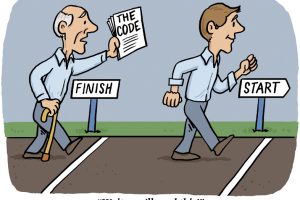By Allan W. Ryan
As I wrap up my final year on the Actuarial Board for Counseling and Discipline (ABCD), I am also presenting my final “Up to Code” article. I decided I would go back four years and revisit the topic of my “Up to Code” article from the September/October 2016 issue of Contingencies.
That article, “Test Your Professionalism IQ,” was presented as an older-style actuarial exam on the subject of professionalism. Given the various restrictions resulting from the coronavirus pandemic, there has been renewed interest in puzzles and games, so I am hoping this new exam will provide entertainment, as well as educational value. Because some of us have a bit more time on our hands, I have made this exam a little longer; you can treat this as an “open book” exam, taking as much time as you need.
A perfect score means you should be volunteering for the ABCD or the Actuarial Standards Board; if your score is below 50%, you need to know that ASOP here does not refer to the ancient Greek who wrote about the tortoise and the hare! Seriously, the expectation is not for a particular score; rather, as you work through the answers, the exam is intended to help you get familiar with professionalism topics and to know where to go for guidance. As an example, the USQS (as defined below) are complicated, and I don’t think many actuaries would think of memorizing them! So, getting a wrong answer is not as important as seeing where you can find the answer and having an overall understanding of the standards.
The exam from four years ago consisted of six multiple-choice and four true-or-false questions, for a total of 10. So, here we go, this time with 12 questions—eight in multiple-choice format and four in true/false format. In order to have a level playing field, the questions have been chosen so as to avoid practice-area-specific topics.
“USQS” refers to Qualification Standards for Actuaries Issuing Statements of Actuarial Opinion in the United States, Including Continuing Education Requirements, effective January 1, 2008. “Code” refers to the Code of Professional Conduct adopted by all five recognized U.S. actuarial organizations. “Actuary” is capitalized to indicate a member of at least one of the five actuarial organizations which have adopted the Code. Statement of Actuarial Opinion, within the meaning of the USQS, is abbreviated SAO.
The answers can be found following the quiz at the bottom of this page, along with explanations as appropriate. Good luck!
ALLAN W. RYAN, MAAA, FSA, is a member of the Actuarial Board for Counseling and Discipline.
Multiple Choice
Question 1
Which of the following statements are true?
Precept 2 (Qualification Standards) of the Code requires that an Actuary comply with applicable qualification standards promulgated by a jurisdiction other than the United States when performing actuarial services under such jurisdiction.
An Actuary who provides actuarial services without compensation is bound by the Code, but such services are not covered by the USQS.
As of December 31, 2020, an Actuary has earned 35 hours of continuing education credits in 2019, and 23 hours in 2020. In order to issue an SAO in 2021, the Actuary must obtain 2 hours of credit in 2021 prior to issuing the SAO (assume the professionalism and organized activities requirements have been met).
o A. 1 only
o B. 2 only
o C. 3 only
o D. 1 and 3
o E. All
Question 2
Which of the following statements are true with respect to ASOP No. 1, Introductory Actuarial Standard of Practice?
It applies to all practice areas.
“Deviation” is defined as departing from the guidance of an ASOP.
It describes the format that all ASOPs follow.
o A. 1 only
o B. 2 only
o C. 1 and 2
o D. 1 and 3
o E. All
Question 3
ASOP No. 56, Modeling, recently adopted by the Actuarial Standards Board (ASB), is effective October 1, 2020, and applies to all practice areas. Which of the following statements are true with respect to ASOP No. 56?
The guidance in this ASOP should not be applied prior to the effective date.
When relying on models developed by others, including “experts” in other fields of knowledge, the Actuary should state the extent of such reliance.
When relying on data provided by others, the Actuary should refer to ASOP No. 23, Data Quality, and ASOP No. 41, Actuarial Communications.
o A. 2 only
o B. 3 only
o C. 1 and 2
o D. 2 and 3
o E. All
Question 4
With respect to actuarial standards of practice, which of the following statements are true?
Precept 3 of the Code requires that actuarial services performed under the Actuary’s supervision meet applicable standards.
ASOP No. 41, Actuarial Communications, sets forth what is required when an Actuary deviates from an ASOP.
The binding guidance of an ASOP includes the Transmittal Memorandum and Appendices.
o A. 1 only
o B. 1 and 2
o C. 1 and 3
o D. 2 and 3
o E. All
Question 5
ASOP No. 41, Actuarial Communications, is perhaps the most widely applicable ASOP. Which of the following statements are true?
This standard does not apply to oral communications.
The standard generally does not apply to marketing brochures.
An actuarial communication should disclose the extent of reliance on other sources for data or other information.
o A. 3 only
o B. 1 and 2
o C. 2 and 3
o D. 1 and 3
o E. All
Question 6
Which of the following correctly describe functions of the Actuarial Board for Counseling and Discipline (ABCD)?
Responding to Requests for Guidance, where an Actuary can discuss, on a confidential basis, a question or issue with an ABCD member.
Imposing discipline on Actuaries for material violations of the Code.
Counseling an Actuary for violations of the Code that do not rise to the level of discipline.
o A. 2 only
o B. 1 and 2
o C. 1 and 3
o D. 2 and 3
o E. All
Question 7
With respect to the USQS, which of the following statements are true?
An SAO may be issued jointly by two actuaries, in a case where neither one of the Actuaries alone would be qualified to issue the SAO, as long as the two Actuaries collectively meet the requirements as stated in the USQS.
Continuing education credit earned toward the General Qualification Standard may not be applied to the Specific Qualification Standard.
To satisfy the continuing education requirement of the General Qualification Standard, an Actuary must have at least 3 hours of credit on professionalism topics from “organized” (as defined by the USQS) activities.
o A. 1 only
o B. 2 only
o C. 1 and 2
o D. 2 and 3
o E. All
Question 8
ASOP No. 23, Data Quality, (revised effective April 1, 2017) is a widely applicable standard. Which of the following statements are true with respect to this standard?
The standard does not require the Actuary to perform an audit of the data (as “audit” is defined in the standard).
The Actuary may rely on data supplied by others, subject to the guidance contained in the standard.
When an Actuary relies on data supplied by others, a review of the data is not required.
o A. 2 only
o B. 1 and 2
o C. 2 and 3
o D. 1 and 3
o E. All
True or False
Question 9
A violation of the Code must have a financial impact in order to be material.
o True o False
Question 10
An Actuary sees a potential conflict of interest with respect to a particular engagement. The Actuary, however, believes her ability to act fairly is unimpaired. In order to accept the engagement in good conscience, the potential conflict should be disclosed to all principals who could be affected, and such principals should expressly agree to the Actuary taking on the assignment.
o True o False
Question 11
An Actuary who is terminated by his or her employer, which then hires a replacement, has no obligation to communicate with, or provide any information to, the replacement.
o True o False
Question 12
An Actuary is required to respond to any request for information from the ABCD unless prohibited by applicable law or confidentiality requirements.
o True o False
Up to Code: Follow-Up Exam—Answers
1. D
1 is true per Code Annotation 3-1. Acting as a volunteer/not being compensated does not change the Actuary’s obligations under the Code and USQS, making 2 false. Number 3 is true: 5 hours from 2019 may be carried forward, so that the total for 2020 is 28. The 2 credits needed for 2020 may be earned in 2021 but must be earned prior to issuing an SAO (and the hours do not count toward 2021).
2. E
This ASOP applies to all practice areas and is intended to provide the “template” for all ASOPs; its binding guidance includes defining terms for purposes of all ASOPs, such as “deviation.”
3. D
There is no reason not to apply the guidance immediately, so 1 is false. The ASOP provides detailed guidance on reliance, making 2 and 3 true.
4. B
Transmittal Memoranda and Appendices provide useful information but are not binding guidance. Only the ASOP itself is binding (see section 3.2 of ASOP No. 1).
5. C
1 is false as the ASOP applies to all communications, oral and written (including electronic). 2 is true as long as the brochures do not include actuarial opinions/findings. Guidance on reliance is provided in the ASOP, and 3 is true.
6. C
1 and 3 correctly describe ABCD functions. 2 is false, because the ABCD recommends discipline to the organizations of which the Actuary is a member; only the recognized actuarial organizations can impose discipline on their members.
7. A
The USQS provides the requirements for jointly issued SAOs, making 1 true (see Section 2.4 of the USQS). 2 is false; recognizing that credit for the specific standard must meet certain requirements, there is nothing preventing credit being applied to both the general and specific standards (see Section 3.3 of the USQS). 3 is false; while 3 hours of professionalism topics are required, they do not have to be “organized” (see Section 2.2.2 of the USQS).
8. B
The Actuary is generally required to “review” the data (as defined in the standard) but not to perform an audit, making 1 true. The standard provides guidance on reliance (making 2 true), but 3 is false, as a review is generally required for data provided by others. (See ASOP No. 23.)
9. False
Annotation 13-1 of the Code defines “material” as “important” or “affecting the outcome of a situation,” as opposed to “trivial,” “not affecting an outcome,” or “merely of form.” There is nothing that states that a financial impact is necessary to make a violation material.
10. True
The statement is a summary of Precept 7, Conflict of Interest.
11. False
See Precept 10 of the Code: Courtesy and Cooperation. Annotation 10-5 would generally require the Actuary to cooperate with a successor, as requested by the employer, to provide relevant information (subject to receiving reasonable compensation).
12. True
Precept 14 addresses cooperation with “an appropriate counseling and disciplinary body of the profession.”





